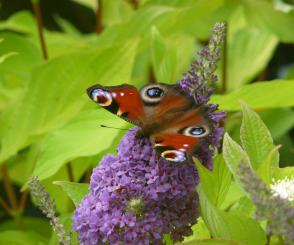At last, after writing about the lack of them, we have good numbers of butterflies in our garden! They are beginning to appear on warm, calm days – the poor things, like us, have not had enough of these! The range of species is definitely down this year, but they bring another dimension to the garden with their bright colours and movement. Along with bees and hoverflies, they are feeding on their favorite plants that include summer flowering shrubs and a range of late flowering perennials - so important for these and other insects.

The new Asters that I purchased are doing very well and the bees love them. Asters really are the stalwarts of our late border color and we have chosen varieties that will flower from now until October. Aster divaricatus is first to flower from late July in our garden, its starry white flowers tumbling over a terrace under some Birch Trees. It is an excellent Aster for dry shade, whereas most prefer retentive soil and sun to do well. Aster ‘div’ as we call it is followed by others that include ‘Little Carlow’ with tall upright growth and true blue flowers that have dark centres, and ‘Winston S Churchill’ a beautiful deep magenta red double with a contrasting yellow center. All make excellent cut flowers as well as being food plants for a huge range of butterflies and other insects.
My Rudbeckia Goldsturm, spurred on by the rain, has spread into a sunny sheet of brown centred daisies that will flower until the end of September. We also have a much taller growing variety called ‘Herbstsonne’ (Autumn Sun) that reaches over two metres and has lemon yellow flowers with the same drooping petals but a limy green central cone that adds to its charm. We have it planted behind some double white Japanese Anemones and the two create a cool combination amongst the vibrant orange of a late Red Hot Poker and the bright golden daisies of the lower growing ‘Goldsturm’.
Now..... where did I put my Observer’s book of Butterflies?
Happy gardening!
Mr McGregor
